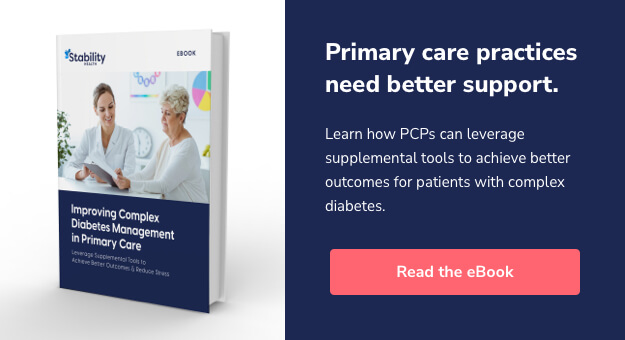
Reducing Hospital Readmissions for Diabetes: Context & Solutions
According to the Institute for Healthcare Improvement (IHI), patients returning within 30 days of a previous inpatient stay account for a substantial number of all hospitalizations in the U.S. The specific cause of their return may be poor recovery from care or to receive treatment for a worsening chronic condition; however, high rates of hospital readmissions can be attributed to much deeper, systemic issues in American healthcare systems.
Readmission can often be a direct result of events that occur — or don’t occur — while a patient is still in the hospital. A lack of timely intervention; physicians and nurses without knowledge of a specific condition; and overcrowded emergency departments can all lead to a patient’s swift return. Each of these issues has roots in patient flow, or “the movement of patients through a healthcare facility.”
To achieve ideal flow and avoid readmission, hospitals would need to deliver the right care, in the right place, at the right times, and for the right length of time, as well as prepare patients for life post-discharge. Failure to do so puts patients at risk for suboptimal care, harm, or even death.
Reducing hospital readmissions for complex, chronic illnesses like diabetes will require a multi-pronged approach that prioritizes timely, quality care delivered by informed and supported clinicians. To do so, hospitals need to think holistically about addressing the needs of high-risk patients before, during, and following discharge.
How Is Hospital Readmission Defined?
“Readmission” is defined as a patient who is admitted to the hospital within 30 days of an initial stay for the same or a related condition. Readmission can result from a wide range of precipitating factors, but frequent causes involve:
- The presence of complex, high-risk conditions
- Poor patient education or guidance at the time of discharge
- Inefficient, uncoordinated discharge or transition plans
- The presence of certain socio-demographic factors; specifically frailty, advanced age, and/or lower income
- Lack of support system at home
Hospital readmissions cost Medicare roughly $26 billion annually, with preventable or avoidable conditions accounting for $17 billion. Avoidable conditions include infections, bed sores, and improper medication dosage, but the top clinical conditions associated with hospital readmission include:
- Septicemia
- Heart failure
- Chronic obstructive pulmonary disease (COPD)
- Diabetes mellitus
- Alcohol-related disorders
- Depressive, psychotic, and/or other mood disorders
The majority of inpatient care is focused on minute details rather than holistic patient support. On one hand, this is part of what makes healthcare in the U.S. so comprehensive; on the other, a lack of holistic patient treatment carries significant risks post-discharge.
For example, in treating patients who require insulin during inpatient admission, nurses and physicians may dose an insulin drip at a granular level: minute by minute, hour by hour, becoming accustomed to the incremental adjustments needed to keep patients stable. However, clinicians with such a narrow range of focus risk neglecting other, more long-term patient needs, such as information or support the patient may require once they leave the hospital.
Once a patient leaves the hospital in stable condition, acute care teams immediately turn their focus to the next critically ill patient. This leaves any follow-up responsibilities to primary care clinicians, who may also lack important information about the patient’s hospital course and condition at the time of discharge. Poorly executed patient discharges pose a higher risk of readmission, a cycle that can repeat needlessly each time the patient is not effectively supported.
Why Reducing Your Patient Readmission Rate Is Critical
Accountable Care Organizations (ACOs) and other value-based models of care are uniquely positioned to work with patients to ensure they receive care in the most appropriate setting based on their health needs. Financial incentives encourage organizations to strive for quality over volume of care — but hospitals often lack specific guidance in how to achieve higher quality.
In 2012, Centers for Medicare and Medicaid Services (CMS) began penalizing hospitals with excessive readmissions by withholding up to 3% of payments from insurance providers. In 2020, CMS fined 2,499 hospitals an estimated $521 million for readmissions alone.
Despite the threat of these financial penalties, the potential cost does not drastically affect a hospital’s bottom line — at least, not enough to spur significant change. CMS’ Hospital Readmissions Reduction Program (HRRP) incentivizes hospitals to improve communication, care coordination, and patient engagement in order to reduce avoidable readmissions, but does not provide specific solutions for addressing these issues.
The need to reduce readmissions is critical for hospitals whose finances directly correlate to the quality of the care they deliver. A healthy patient population is the primary objective for every healthcare system, but ensuring the highest quality care also helps keep costs down, prevents financial penalties, and makes funds available for implementing new, innovative care solutions.
Reducing Hospital Readmissions for Diabetes
Readmission for diabetes-related complications is most often attributed to the following:
- Hyperglycemia or hypoglycemia
- Onset or worsening of other diabetes-related symptoms
- Lack of ability to adhere to care recommendations (often due to factors outside of the patient’s control)
- Lack of understanding of treatment
- Inaccurate or incomplete care instructions
Readmission rates for diabetes vary between hospitals and states, but a few specific adjustments have resulted in system-wide improvements. Fewer patients with complex diabetes are readmitted to hospitals that:
- Correctly identify the root (often non-medical) cause of readmission
- Provide comprehensive patient education or connection to expert-driven support services at time of discharge
- Leverage technology to mitigate patient risk
- Improve discharge planning and transitional care by partnering with care coordination services that prioritize high-risk patients
Determine the Root Cause of Readmission
Many individuals with diabetes rely on the ED for non-emergency services for a host of external reasons, including:
-
- Lack of or delayed access to primary, specialty, or mental health services
- Lack of familiarity with other options for care
- Availability of 24/7 care
- Belief that the ED provides the best care
Though many patients admitted to an ED are experiencing a specific medical issue, the root causes of a readmission may run much deeper. Factors like housing instability, transportation challenges, food insecurity, and other social determinants of health may increase the risk of readmission to the ED within 30 days of discharge.
To mitigate this issue, intake and attending nurses should screen patients for anxiety, dementia, depression, or stress related to any of the factors listed above, using a standard screening for social determinants of health. According to a survey by Deloitte, 88% of hospitals currently screen ED patients for social determinants, but only 62% screen consistently or systematically. Doing so would help providers identify patients at higher risk for readmission and prepare an appropriate discharge plan.
Provide Resources for Patient Engagement & Discharge Guidance
A patient’s education and engagement level can have a major effect on their chances of readmission. Pre-discharge, care teams need to ensure that both the patient and their family understand the responsibilities and roles involved in the patient’s recovery process and disease self-management. If they are capable, the patient should be involved in designing their post-discharge care plan to ensure their own adherence.
Dr. Michael S. Oleksyk, MD, Vice President of Medical Affairs and Chief Medical Officer of Baptist Health Care in Pensacola, Florida proposes the following as an ideal discharge plan:
-
- Focus on plans for discharge as soon as the patient is admitted.
- Physicians, nurses, case managers, social workers, therapists, family members, and the patient all need to work together during the patient’s stay to address all post-discharge needs.
- The patient’s discharge team should ensure the patient is able to obtain all medications; Higher performing hospitals routinely include clinical pharmacists on the the discharge team to assist with education and medication reconciliation.
- Ensure that there is prompt discharge follow-up with the primary care clinician and other post-acute organizations that might be involved.
Developed by Boston University and Boston Medical Center, Project RED (Re-Engineered Discharge) also provides a guide to optimizing the discharge process. In order to effectively implement a plan like Dr. Oleksyk’s or Project RED, hospitals and healthcare systems may need to hire an implementation specialist to ensure all departments have the resources they need to follow the recommended guidance.
Optimize Your Technology to Reduce Readmissions
Healthcare communication technology is very tightly regulated, and for good reason: Providers need to protect patients and their privacy. However, while EMR software may pose challenges when it comes to data-sharing between practices, coordinated, virtual care solutions for complex conditions can help patients adhere to their discharge and post-discharge care instructions with expert oversight.
Hospitals can also perform their own patient data analysis to determine which patients are most at risk for readmission, whether due to social determinants of health or specific health conditions.
Improve Transition Communication
Communications between the discharge team and the receiving provider is often the point at which both parties miss crucial information about a patient’s condition. The Joint Commission for Transforming Healthcare recommends that handoff communications:
-
- Be two-way conversations between the hospital care team and the receiving provider
- Eliminate or limit interruptions
- Provide time for the receiving provider to ask questions
- Contain up-to-date information on the patient’s condition, treatment, care plan, services required, recent changes, and anticipated problems
- Afford appropriate time for the receiver to review the patient’s history
- Confirm the receiver’s understanding using the teach-back technique
Each discharge should be managed by a nurse or other practitioner who is familiar with the patient and acts as their transition coach. Transition plans do not need to be complicated; For example, at time of initial discharge, every patient with complex diabetes receives a referral to a relevant supplemental service. Embedding simple, standard rules like this into the discharge process will ensure that every patient gets what they need, when they need it, and reduces their risk of readmission.
Partner with Coordinated Care Solutions to Reduce Hospital Readmissions
When hospitals work with coordinated care services, they receive expert support and guidance for chronic disease management and other acute conditions. Services that fill the gap between discharge and post-acute care offer a solution for a holistic approach to patient transition. They can also positively affect a hospital’s bottom line: Hospitals in value-based payment models can experience significant cost savings by reducing a patient’s length of stay, avoidable complications, ED visits, hospitalizations, and readmissions. Additionally, the potential ROI of avoiding readmissions could help fund innovative solutions for complex illnesses like Stability Health.
Focusing on high-risk patients with complex diabetes, Stability Health follows a transition plan very similar to the one proposed by Project RED. Medication reconciliation, patient education, and primary care communication at time of discharge form the pillars of the Stability Health Care Transition program.
Connection to a patient’s primary care clinician is particularly valuable post-discharge. Since most patients with diabetes rely on their primary care clinician for specialized care, they may miss crucial guidance specific to their condition. Primary care clinics that lack the resources to fill these gaps can benefit from leveraging expert-backed, third-party resources that will tailor treatment recommendations to the specific patient and work with clinicians to prevent an avoidable readmission.
With a mission that drives clinician support and patient engagement, Stability Health provides tailored education when both parties need it most, in a format that’s most appropriate for each. Expert-supported interventions for diabetes empower patients to avoid hospitalization, self-manage their disease, self-advocate in and outside their clinician’s office, and connect to their own care.



